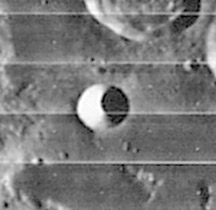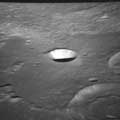Difference between revisions of "Schmidt"
| Line 17: | Line 17: | ||
<br /> | <br /> | ||
==Description: Elger== | ==Description: Elger== | ||
| − | ''([[IAU% | + | ''([[IAU%20directions|IAU Directions]])'' SCHMIDT.--A bright crater at the foot of the S. slope of [[Ritter|Ritter]].<br /> <br /> |
==Description: Wikipedia== | ==Description: Wikipedia== | ||
[http://en.wikipedia.org/wiki/Schmidt_%28lunar_crater%29 Schmidt]<br /> <br /> | [http://en.wikipedia.org/wiki/Schmidt_%28lunar_crater%29 Schmidt]<br /> <br /> | ||
==Additional Information== | ==Additional Information== | ||
| − | * Depth data from [[Kurt%20Fisher% | + | * Depth data from [[Kurt%20Fisher%20Crater%20Depths|Kurt Fisher database]] |
** Arthur, 1974: 2.31 km | ** Arthur, 1974: 2.31 km | ||
** Westfall, 2000: 2.31 km | ** Westfall, 2000: 2.31 km | ||
Latest revision as of 02:16, 16 April 2018
Contents
Schmidt
|
Lat: 1.0°N, Long: 18.8°E, Diam: 11 km, Depth: 2.31 km, Rükl: 35 |


Left: LO-IV-085-H1 The crater along the top margin is Ritter, with a small piece of Sabine visible to its lower right. Right: Apollo 10 AS10-31-4629 Schmidt viewed obliquely from the northeast, with Sabine in the foreground.
Images
LPOD Photo Gallery Lunar Orbiter Images Apollo Images
- AS11-37-5448 shows Schmidt during the early post-sunrise hours. The bright unrecognizable dot near the crater's southern rim ("left" of the crater) is Apollo 11's distant CSM Columbia. - DannyCaes Nov 18, 2007
- An extreme king-size version of AS11-37-5448 in Kipp Teague's extraordinary Project Apollo Archive, shows the true appearance of the distant manmade CSM Columbia and the roughness of the moon's cratered surface in the background. Note the pitch-black shadow on Schmidt's floor. A superb photograph!!! - DannyCaes Dec 1, 2007
Maps
(LAC zone 60D3) LAC map Geologic map LM map AIC map
Description
Description: Elger
(IAU Directions) SCHMIDT.--A bright crater at the foot of the S. slope of Ritter.
Description: Wikipedia
Additional Information
- Depth data from Kurt Fisher database
- Arthur, 1974: 2.31 km
- Westfall, 2000: 2.31 km
- Viscardy, 1985: 2.3 km
- TSI = 20, CPI = 5, FI = 10; MI =35 Smith and Sanchez, 1973
Nomenclature
- The present IAU name honors three men:
- Johann Friedrich Julius Schmidt (October 25, 1825– February 7, 1884) was a German astronomer, and one of the foremost lunar observers of his day. By 1874 he put the finishing touches to his map of the Moon. This was the first map of the Moon to surpass the celebrated map of Beer and Mädler. See extended biography.
- Bernhard Voldemar Schmidt (March 30, 1879–December 1, 1935) was an Estonian-born optician who lived in Germany. In 1931 he invented the Schmidt telescope which corrected for spherical aberration by placing a corrector lens in front of the mirror. His many accomplishments as a practical optician and telescope builder are all the more remarkable considering that he had lost most of his right arm in a childhood accident.
- Otto Yulievich Schmidt (30 September 1891 — September 7, 1956) was a Soviet scientist, mathematician, astronomer and geophysicist. In mid 1940s, Schmidt suggested a new cosmogonical hypothesis on the formation of the Earth and other planets of the Solar system.
- According to Whitaker (p. 221), the name Schmidt (presumably honoring J.F.J Schmidt) was introduced by Birt and Lee.
- The name (honoring J.F.J Schmidt) was part of the original IAU nomenclature of Blagg and Müller (1935).
- The other two Schmidt's were added as part of the list approved by the IAU in 1970 and published in Menzel, 1971.
LPOD Articles
24 BLÄTTER , RED ARROWHEAD, Schmidt’s Map Reviewed (1879), Swell Linne
Bibliography
- Harold Hill. A Portfolio of Lunar Drawings, pages 6, 7 (the Sabine & Ritter region).
Johann Friedrich Julius Schmidt in the Sourcebook Project (William R. Corliss)
(articles in which J.F.J.Schmidt is mentioned)
- In Mysterious Universe, a handbook of astronomical anomalies (1979) :
- Page 48: A Supposed New Interior Planet (Monthly Notices of the Royal Astronomical Society, 1859).
- Page 50: The New Planet (Scientific American, 1864).
- Page 196: On the Obscuration of the Lunar Crater Linne (W.R.Birt, American Journal of Science, 1867).
- Page 199: The Linne Controversy, a look into the past (Patrick Moore, Journal of the British Astronomical Association, 1977).
- Page 287: The Stationary Radiation of Meteors (W.F.Denning, Observatory, 1913).
Another Schmidt, in :
- Page 614: Was there Really a Big Bang? (G.Burbidge, Nature, 1971).